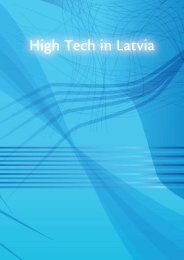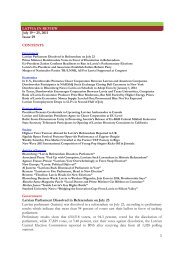Latvian Folk Dress - Latvijas Institūts
Latvian Folk Dress - Latvijas Institūts
Latvian Folk Dress - Latvijas Institūts
You also want an ePaper? Increase the reach of your titles
YUMPU automatically turns print PDFs into web optimized ePapers that Google loves.
<strong>Latvian</strong><br />
<strong>Folk</strong><br />
<strong>Dress</strong><br />
almost completely disappeared. However in some remote districts with<br />
strong national awareness and traditions, such as Alsunga, Rucava and<br />
Nīca (in Kurzeme), ethnic dress continued to be worn as festive clothing<br />
until the 1940s.<br />
The revival of folk dress as dress for festive occasions occurred during<br />
the first era of the Republic of Latvia in the 1920s and 1930s. There<br />
was great interest in the newly established nation and the history and<br />
culture of its people. Partly this was because earlier, the popularisation<br />
of <strong>Latvian</strong> values was prohibited, and partly this was because people<br />
had to work on lifting their own level of self-confidence after 700 years<br />
of oppression. From the mid-1920s, ethnographic expeditions began<br />
to travel throughout Latvia as ordered by the Monuments Authority,<br />
gathering all possible remaining evidence about the traditional life of the<br />
people, including folk dress. In this way a large collection of elements of<br />
authentic folk dress was established, which ended up in the collection<br />
of the National Museum of History. One of the most active folk dress<br />
researchers and promoters was Ādolfs Karnups and Elga Kivicka, who in<br />
1938 published an overview of the ethnographic costumes of <strong>Latvian</strong><br />
regions, identifying the characteristic features of each. The publication<br />
was created based on folk dress elements from each district which were<br />
A photo from the film <strong>Latvian</strong> Wedding in Nīca, produced in 1931,<br />
shows local people wearing their original dresses.<br />
held by the museum. Using the place of origin as the main principle<br />
of composition, unfortunately ensembles were created using elements<br />
of dress which had rarely been worn by the same person – that is,<br />
there could be an interval of around 100 years in the dating of various<br />
elements of dress in the ensembles. Nevertheless the influence of this<br />
publication was huge, and it influenced a majority of folk dress makers.<br />
These costumes were made for choir singers, theatre performances and<br />
individual wearers. In the 1930s interest in folk dress was so great that<br />
not only the society ladies in Rīga, but even women in the outermost<br />
corners of Latvia strove to get a self-made or pre-ordered folk costume.<br />
The making of folk dress for the needs of choirs and dancing ensembles<br />
was preserved also during the period of Soviet occupation after the<br />
Second World War, a rarely-permitted expression of patriotism.<br />
When the folklore movement began in the late 1970s, with the aim of<br />
reviving ancient folk songs and traditions, all participants in folkloric<br />
groups acquired folk dress. A majority of <strong>Latvian</strong> choirs, dance ensembles<br />
and participants in folkloric groups still wear ethnographic folk dress<br />
when performing. However, during the time of occupation some choirs<br />
attempted to make themselves ancient dress. The wearing of ancient<br />
costumes in the folklore movement was begun by the men’s group<br />
32 33






